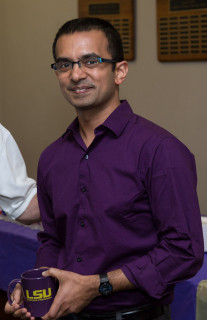LSU Math Professor Publishes First-Of-Its-Kind Book
 LSU Shirley Blue Barton Professor of Mathematics Dr. Pramod Achar recently published a book titled Perverse Sheaves and Applications to Representation Theory, which aims to guide new researchers in the field of representation theory and its links to topology/geometry. Achar explained that while much of the information was available in scholarly literature, it was frequently only found in decades-old research monographs and it was written in a way that only someone familiar with the topic could fully understand. With his new book, Achar hoped to compile this information and present it in a way that junior researchers and PhD students could comprehend. “I am already finding it useful in introducing new graduate students to some of the tools in geometric representation theory,” Achar stated.
LSU Shirley Blue Barton Professor of Mathematics Dr. Pramod Achar recently published a book titled Perverse Sheaves and Applications to Representation Theory, which aims to guide new researchers in the field of representation theory and its links to topology/geometry. Achar explained that while much of the information was available in scholarly literature, it was frequently only found in decades-old research monographs and it was written in a way that only someone familiar with the topic could fully understand. With his new book, Achar hoped to compile this information and present it in a way that junior researchers and PhD students could comprehend. “I am already finding it useful in introducing new graduate students to some of the tools in geometric representation theory,” Achar stated.
Representation theory involves studying symmetries using concepts from linear algebra. A discovery about 40 years ago, however, found that some answers to linear-algebraic questions could be answered with topology and geometry. This was a revolutionary discovery and is what Achar’s book hopes to capture. Most of the book, about two thirds, focuses on Sheaf theory, a framework for extracting algebraic structure from topological information. The remainder of the book goes through four representation theory topics which have seen major advances in the past 40 years thanks to Sheaf theory.
Before starting at LSU in 2004, Achar received his PhD in Mathematics from MIT in 2001 and taught at the University of Chicago in his position as L. E. Dixon Instructor of Mathematics from 2001-2004. Growing up in Memphis, Achar had always done well in math but never considered it as a career until he participated in an independent study project with a math professor from Rhodes College. Working with topology, Achar described his experience as “eye-opening… it was so different from what I thought math was… I was captivated by it.” It wasn’t long before Achar decided to pursue math as a career. Still working with the same professor early in his undergraduate studies, Achar learned about what an academic career entailed and decided to go for it. Describing how it feels to be involved with the scientific community, Achar said “It is very much a privilege to have a career in which I have the freedom to pursue projects based primarily on my own curiosity. I am grateful to my teachers and my peers who have helped me find success in this career.”
(Contact: Landon Troxclair)